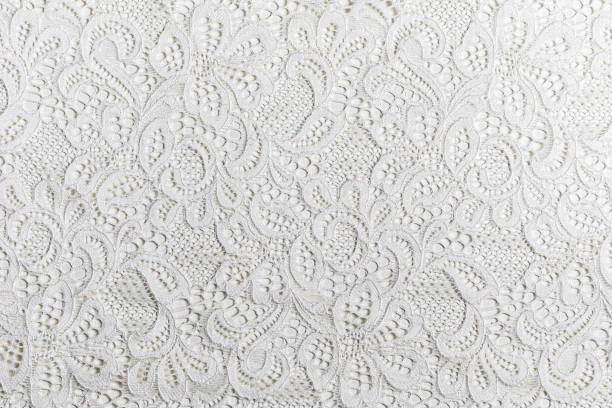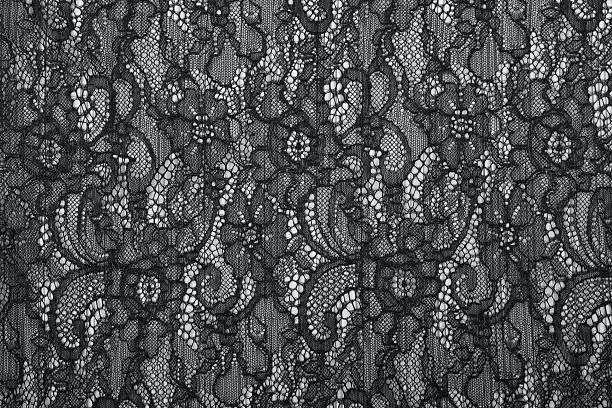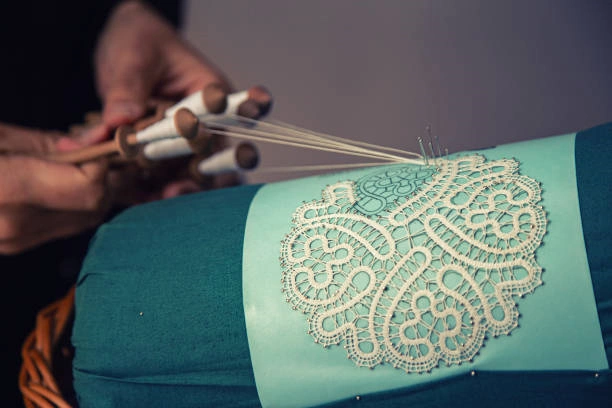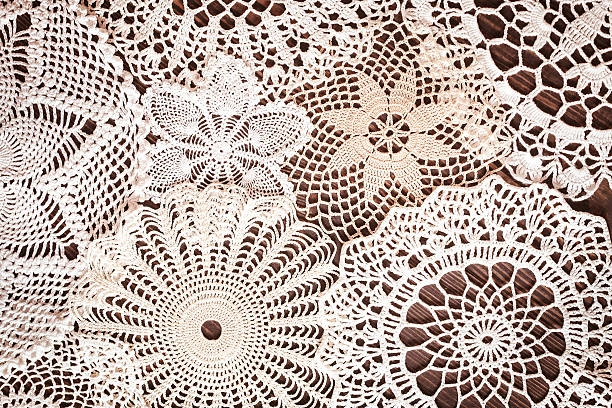Lace conjures up images of exquisite wedding gowns, heirloom linens, and sophisticated fashion details, and every piece bears witness to exquisite craftsmanship. But have you ever stopped to explore the magic behind lace? How is lace fabric made? How does it transform from a simple thread into such an intricate openwork art? It’s a fascinating journey that combines ancient craftsmanship with the wonders of modern technology. Join us as we delve into the intricacies of lace, from the nimble fingers of the artisan to the delicate dance of the machine, and uncover the true artistry that goes into each and every lace thread.
The Essence of Lace: What Makes It Unique?

Before we explore the “how,” let’s define “what” makes lace distinct. Unlike woven or knitted fabrics that are built upon a continuous ground, lace is characterized by its open, net-like structure and intricate, often isolated, decorative motifs. This unique construction is achieved by twisting, looping, or braiding threads to create patterns with open spaces, rather than a solid fabric. This inherent openness is what gives lace its delicate, airy, and translucent quality, making it a beloved choice for adding elegance and refinement to countless items.
The Historical Evolution of Lace Making

To truly appreciate how lace fabric is made today, we must first glance back at its rich history. Lace making emerged in Europe during the late 15th and early 16th centuries, with Italy and Flanders often credited as its birthplaces. Initially, it was a laborious and time-consuming handicraft, accessible only to the wealthy elite.
Key Historical Lace Making Methods:
- Needle Lace (Punto in Aria): Considered the earliest form, needle lace is built entirely with a needle and thread, using variations of buttonhole stitches to create an openwork pattern from scratch. It’s incredibly intricate and often produces a more sculptural, raised effect.
- Bobbin Lace (Pillow Lace): Developed concurrently, bobbin lace involves braiding and twisting threads wound on bobbins, which are then systematically manipulated and pinned onto a pillow following a pricked pattern. Different combinations of twists and crosses create various stitches and textures.
These foundational hand methods laid the groundwork for all subsequent lace innovations, demonstrating the ingenuity of early artisans in transforming simple fibers into complex textile art.
The Human Touch: Handcrafted Lace Fabric
Even in our modern, machine-driven world, handcrafted lace endures as a highly prized art form. The question of how lace fabric is made by hand speaks to dedication, skill, and an almost meditative patience.
1. How is Needle Lace Fabric Made by Hand?
Needle lace, also known as “point lace,” is often considered the pinnacle of lace-making artistry due to its unparalleled intricacy and durability.
- Materials: Fine linen or cotton threads, a very fine needle, parchment or paper pattern, and a backing fabric.
- Process:
- Pattern Transfer: The design is drawn onto parchment or thick paper and then basted (lightly stitched) onto a sturdy backing fabric.
- Outline Creation: A foundation of heavier thread is couched (stitched down) along the main outlines of the design.
- Filling the Gaps: The lacemaker then uses the needle to create a series of incredibly small, dense buttonhole stitches, working within the couched outlines. These stitches are built up row by row, creating a solid, raised effect for the motifs.
- Connecting the Motifs: Openwork sections, called “brides” or “bars,” are created by looping threads between motifs, filling in the gaps with decorative stitches. Sometimes, a fine net ground is built stitch by stitch.
- Detaching: Once the entire piece is complete, the basting stitches are carefully cut, and the lace is delicately removed from the backing fabric.
Needle lace can take hundreds, if not thousands, of hours for a single piece, resulting in a lace that feels almost three-dimensional.
How is Bobbin Lace Fabric Made by Hand?

Bobbin lace is recognized by its flowing lines and a typically flatter appearance compared to needle lace.
- Materials: Numerous bobbins (wooden spools) with wound threads (linen, cotton, silk), pins, a specialized lace pillow (often cylindrical or bolster-shaped), and a pricked pattern.
- Process:
- Pattern Placement: A detailed pattern, pricked with tiny holes to indicate pin placements, is attached to the lace pillow.
- Thread Setup: Pairs of bobbins are attached to the top edge of the pattern, with threads draped over pins.
- Twist and Cross: The lacemaker manipulates the bobbins in specific sequences of “twists” (one thread over another within a pair) and “crosses” (interchanging threads between pairs).
- Pinning: After each set of twists and crosses, a pin is inserted into a pricked hole on the pattern to secure the threads and maintain tension.
- Working Progressively: The lacemaker works downwards, systematically twisting, crossing, and pinning, gradually building up the lace fabric, thread by thread. Different combinations of twists and crosses create various stitches like cloth stitch (dense), half stitch (open), and plaits.
- Finishing: Once complete, the pins are removed, and the finished bobbin lace emerges from the pillow.
Bobbin lace is incredibly versatile, allowing for a wide range of patterns and textures.
The Mechanical Marvel: How is Lace Fabric Made by Machine?
The Industrial Revolution brought about a revolutionary change in lace production. The demand for lace surged, and hand production simply couldn’t keep up. This led to the invention of sophisticated machines capable of replicating the intricate work of lacemakers. The question of how lace fabric is made shifted dramatically with these innovations.
Key Machine Lace Production Methods:
- Leavers Machine Lace: This is arguably the most common and versatile method for producing high-quality machine-made lace that closely mimics the look and feel of traditional bobbin lace.
- Principle: The Leavers machine uses a complex system of warp threads (running lengthwise) and weft threads (running crosswise) combined with intricate bobbin threads that twist around each other, much like hand bobbin lace. It can produce a wide variety of patterns, including delicate grounds and heavy motifs.
- Characteristics: Often features detailed patterns, good drape, and can incorporate multiple thread types and colors. It’s used for everything from bridal lace to lingerie and apparel.
- How it Works (Simplified): Hundreds or thousands of bobbins loaded with thread move and twist through a bed of tightly stretched warp threads, creating the lace structure. Guide bars control the movement of the threads to form the desired pattern.
- Raschel Machine Lace: This method is a type of warp knitting, where threads are interlocked using needles to create a ladder-like structure.
- Principle: Raschel machines use a series of needles that form loops, and guide bars that lay warp threads across the needles. The threads are then interlocked to create a fabric.
- Characteristics: Raschel lace tends to be flatter, more uniform, and often has less intricate openwork than Leavers lace. It can be produced very quickly and affordably. It’s commonly used for stretch lace, trim, and some apparel.
- How it Works (Simplified): A knitting machine uses needles to form loops from warp threads. Guide bars move threads laterally to connect these loops and create patterns. The patterns are usually simpler than Leavers lace.
- Embroidery Machine Lace (Chemical or Guipure Lace): This method involves embroidering designs onto a soluble base fabric, which is then dissolved, leaving only the lace.
- Principle: High-speed embroidery machines stitch elaborate patterns onto a temporary, water-soluble or heat-soluble backing fabric.
- Characteristics: This method creates lace with a very solid, often raised, texture, resembling traditional Guipure lace. It has no net ground; motifs are connected by embroidered “bars.”
- How it Works (Simplified): An embroidery machine stitches a complex design onto a special fabric that dissolves in water (or melts with heat). Once the embroidery is complete, the backing fabric is washed or heated away, leaving only the embroidered lace.
Table: Comparison of Handcrafted vs. Machine-Made Lace
| Feature | Handcrafted Lace | Machine-Made Lace |
|---|---|---|
| Production | Slow, labor-intensive | Fast, high-volume production |
| Cost | Very High (due to labor) | Lower to Moderate (depending on complexity and machine type) |
| Uniqueness | Each piece is unique, with slight variations | Highly uniform, consistent patterns |
| Texture | Often more dimensional, irregular, varied | Flatter, more regular, precise |
| Delicacy | Can be extremely delicate; antique pieces are fragile | Varies; some very delicate, others more robust (e.g., stretch lace) |
| Fraying | Less prone to unraveling due to hand knotting/stitching | Can be more prone to fraying if cut improperly (especially Leavers) |
| Examples | Venetian Needlepoint, Bruges Bobbin Lace, Honiton Lace | Chantilly-style, Alençon-style, Guipure-style, Stretch Lace |
The Finishing Touches: From Loom to Luxury

Once the core structure of the lace is formed, whether by hand or machine, there are often several finishing steps to ensure its beauty and durability:
- Scouring and Bleaching: To clean the lace of any oils or dirt from the manufacturing process and to achieve the desired white or off-white color.
- Dyeing: Lace can be dyed in an endless array of colors to match specific design requirements.
- Embellishment: Some machine-made laces are further enhanced by hand-sewn beads, sequins, or additional embroidery to mimic the luxuriousness of haute couture hand lace.
- Cutting and Trimming: For machine-made lace, the continuous rolls are cut into specific widths or individual motifs are precisely cut from the backing fabric (in the case of chemical lace).
- Quality Control: Each piece is inspected for flaws, snags, or inconsistencies before being packaged for distribution.
Conclusion
The question of how lace fabric is made reveals a fascinating interplay of artistry and technology. From the slow, painstaking beauty of a needle lace artisan to the high-speed precision of a Leavers machine, each method contributes to the vast and varied world of lace.
Understanding these processes not only deepens our appreciation for the textile itself but also helps us make informed choices as consumers and creators. Whether we admire a piece of historical lace in a museum, incorporate a delicate trim into a sewing project, or wear a garment adorned with machine-made lace, we’re connecting with a craft that has evolved over centuries, consistently delivering beauty and intricate detail. The next time you encounter a piece of lace, take a moment to marvel at its construction – the countless threads, carefully twisted, looped, or stitched, coming together to form a truly remarkable fabric, a testament to enduring human ingenuity and artistic expression.
